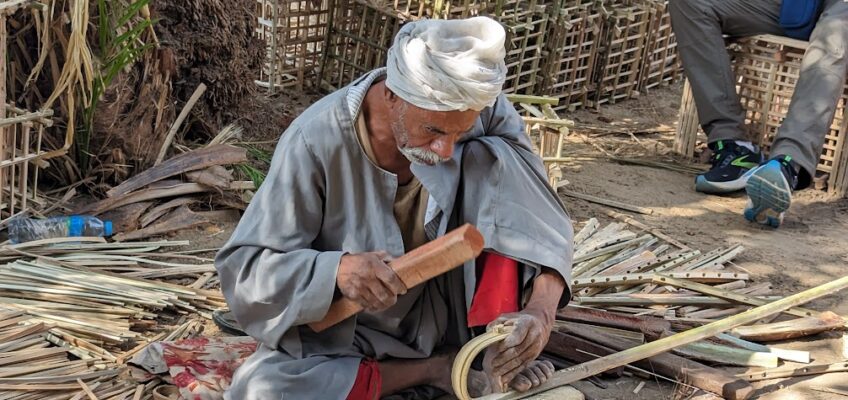We started the day yesterday visiting a craftsman in Fares before continuing upriver to Kom Ombo. The temple there offered some new things to see as well as enhancing our understanding about the images carved in temple walls.
Then in the evening Mo gave us a great talk and Q&A about Islam.
Mohamed and the Palm Fronds
Our boat actually spent the night moored at the small village of Fares. After breakfast we rode in tuk-tuks about ten minutes from the river’s edge to the home and workshop of a man named Mohamed.
Via Mo’s interpreting, Mohamed told us that he is 63 years old. Since childhood he has been creating things from palm fronds. He works six days a week, from morning until 9 or 10 pm, with a break in the afternoon on the hot summer days. He learned from his father, and his son learned from him and helps.
The crates Mohamed makes each hold more than 20 kilograms of mangos. As we watched (and a couple of us assisted), he made two crates in about ten minutes each.
The Temple of Kom Ombo
In the afternoon we arrived at Kom Ombo. Our visit to the temple was at 2:30. Mo told us if we wait until later, all the large cruise ships would be there. To avoid the crowds, we visited in the hottest part of the afternoon. It was only 103, much cooler than last week in Luxor.
As it turned out, the big cruise ships were already arriving and disgorging their passengers. The temple was packed, and becoming packed-er while we visited.
This temple dates from the Ptolemaic period, with later additions by the Romans. Construction began under Ptolemy VI and continued up to Ptolemy XII. On the walls we saw depictions of the crowning of several of these pharaohs.
The unique feature of Kom Ombo is that it is a double temple. One side is dedicated to Horus, the falcon-headed god; the other side is dedicated to Sobek, with the head of a crocodile.

Lower left: cups
Lower right: scalpels (blades at the top)
Above the cups: forceps
Above the forceps: hooks used for extraction
Top center: saw
In a pool next to the temple lived many crododiles back in the day. The crocodile mummies discovered there are now on display in a museum next to the temple.
More photos from Kom Ombo are here.
Islam
“Islam” has the same root as the Arabic word “salaam.” It means “peace.” And that was the first thing Mo talked about. The terrorism and violence we often associate with Islamic extremists have nothing to do with Islam. Mo considers them to be as much about Islam as the KKK is about Christianity.
He described the five pillars of Islam. These are the only requirements of Islam.
- Shahada (faith): The declaration of faith in one God (Allah) and His messenger (Mohammed)
- Salah (prayer): The ritual prayer required of every Muslim five times a day throughout their lifetime
- Zakat (almsgiving): The act of giving a portion of a Muslim’s wealth to those in need throughout their lifetime.
- Sawm (fasting): The act of fasting during the holy month of Ramadan.
- Haj (pilgrimage): The sacred pilgrimage to Mecca required of every Muslim at least once in their lifetime if it is within their means.
Other aspects of religious life are by custom and teaching rather than by requirement, though some are specifically mentioned in the Qur’an. Male circumcision is part of the teaching of the prophet Muhammad and is not in the Qur’an. Female genital mutiliation is also mentioned in Muhammad’s teaching as noble but not required. Most religious leaders today, however, have called for an end to the practice. Still, it is commonly done in Egypt. Mo strongly opposes it. Dietary laws, according to Mo, only require that food be blessed before it is slaughtered, and pork is the only explicitly haram (non-halal) food, as it is mentioned in the Qur’an.
The questions we asked were wide ranging, and the discussion was interesting. I’m traveling with some very thoughtful and insightful people.


Leave a Reply